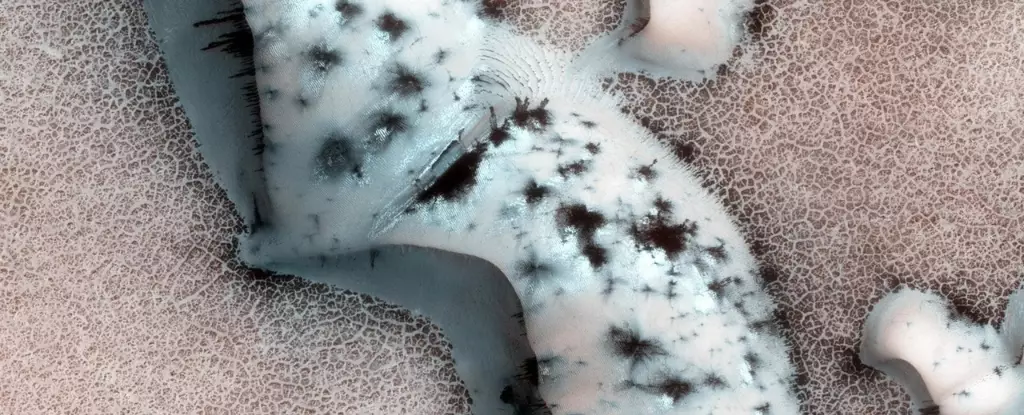Mars, often referred to as the Red Planet, captivates the imagination with its barren and rugged terrain. Unlike Earth, which is teeming with vibrant life and lush landscapes, Mars presents a stark, frozen aesthetic that is both alien and beautiful. Although its environment may seem desolate at first glance, scientific exploration has revealed a remarkable interplay of natural phenomena that contribute to its unique charm. This otherworldly beauty begs for a deeper understanding of the processes that create it, particularly in its polar regions.
At the heart of Mars’ captivating features lies the planet’s thin atmosphere, comprising predominantly carbon dioxide—over 95%. This atmospheric composition leads to fascinating seasonal changes that are unlike any terrestrial experience. During the Martian winter, CO2 freezes, forming a thick, icy mantle that envelops the poles. This frozen layer remains dormant throughout the frigid months, only to awaken as spring approaches. The sunlight that pierces through this translucent ice layer gradually warms the ground below, setting the stage for a spectacular transformation.
As the temperature climbs, the solid CO2 begins to sublimate, transitioning directly from a solid state to gas. This process results in the accumulation of pressurized gases trapped beneath the ice. Ultimately, these forces seek release, creating natural geysers that appear dramatically on the Martian surface. Notably, NASA’s HiRISE camera has been instrumental in capturing these fascinating eruptions, unveiling patterns that adorn the landscape with beauty and mystery.
The geysers of Mars are not merely geological phenomena; they are an expression of nature’s creativity. Some eruptions release dark material over expansive areas, creating spots that can stretch up to a kilometer wide. The sheer power behind these eruptions is astonishing; they can reach speeds of up to 160 kilometers per hour. The eruptions sometimes give rise to peculiar formations resembling spiders, leading to the term “araneiform terrain.” These mesmerizing features feature clusters that create a wrinkled surface, adding to the planet’s visual intrigue.
NASA scientists have conducted laboratory experiments to recreate these patterns, further unraveling the mystique of Martian geology. The Keiffer model provides an explanation for these phenomena, detailing how the seasonal ice cap acts as an impermeable barrier. When gas builds up beneath this icy surface, it creates high-pressure regions that eventually rupture. This results in the release of gas and sand-sized particles, etching intriguing patterns into the Martian landscape.
While Earth presents a vibrant tableau brimming with life, Mars shows a different kind of beauty—one characterized by resilience and the power of elemental forces. Literary traditions have long celebrated Earth’s beauty, focusing on its diverse ecosystems, breathtaking landscapes, and life-sustaining qualities. Yet, the formations on Mars tell a story of a planet shaped by extreme conditions and powerful geological forces.
This dichotomy raises philosophical questions about beauty, nature, and our perception of the universe. As Earthly beings, we often experience a bias toward our planet’s lush environments, yet we must recognize that Mars offers a unique elegance that speaks to the untamed power of nature. The geysers and their resulting features present natural artistry that is distinctly Martian; it is a beauty forged by extreme conditions that cannot be replicated on Earth.
As we continue to explore Mars, the study of its geysers and geological formations offers valuable insight into planetary processes that differ markedly from those on Earth. The enigmatic and stunning CO2 geysers exemplify the intricate beauty and complex interactions that define this frigid world. Appreciating Mars’ distinct characteristics invites scientists, poets, and dreamers alike to envision a broader conception of beauty that transcends our home planet. As the field of planetary science evolves, it sparks curiosity about what other wonders the universe holds, encouraging an ongoing commitment to exploration and understanding the myriad forms of beauty that exist beyond our blue skies.


Leave a Reply